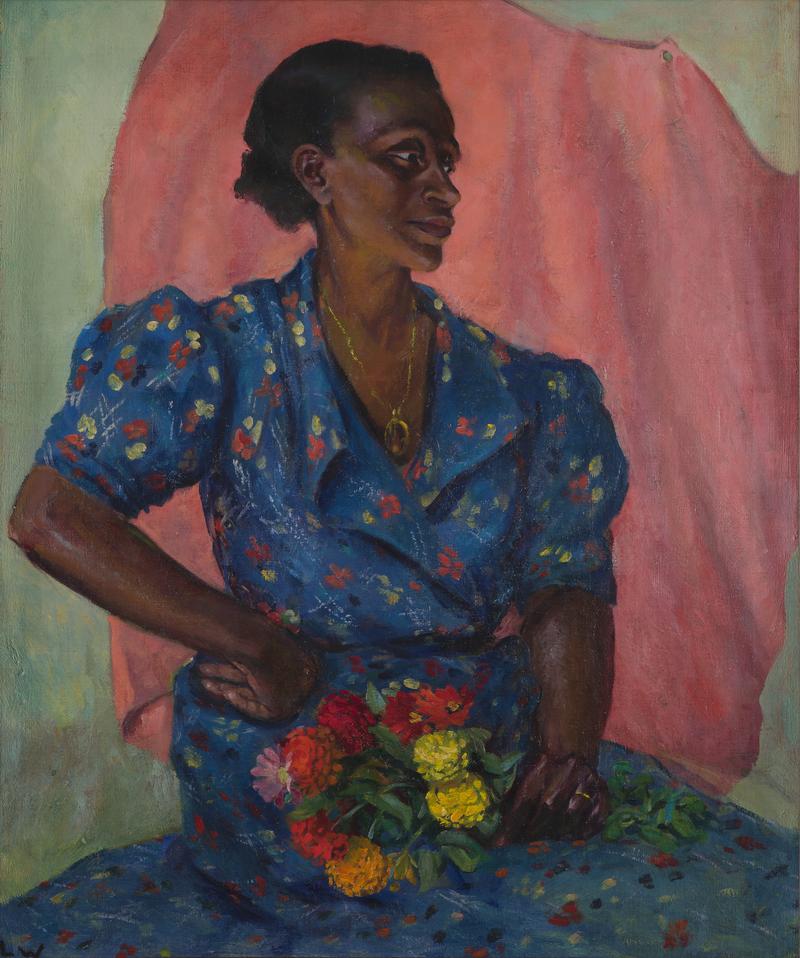The Brooklyn Museum Celebrates 200 Years with Updated American Art Wing

( © Estate of Laura Wheeler Waring (Photo: Brooklyn Museum) )
Title: The Brooklyn Museum Celebrates 200 Years with Updated American Art Wing
[music]
Alison Stewart: This is All Of It on WNYC. I'm Alison Stewart. To celebrate its 200th anniversary, the Brooklyn Museum decided to give its American art galleries a makeover. The installation is called Toward Joy: New Frameworks for American Art and it displays work from more than 7000 pieces in the Brooklyn Museum's American art collection. This includes 120 pieces that haven't been exhibited before. The re-installation engages with the museum's American art collection a bit differently than in the past, reckoning with how to present beautiful art and a complicated history.
Stephanie Sparling Williams is the Brooklyn Museum's Andrew Mellon Carnegie curator of American art. She led the organization of this exhibition, which is now on view. Hi, Stephanie.
Stephanie Sparling Williams: Hello. Good afternoon, Allison.
Alison Stewart: Good afternoon. One of the guiding questions in organizing this exhibition was, how might American art be experienced at this moment? Why was this a question that you thought was helpful in your curation process?
Stephanie Sparling Williams: Absolutely. It was so important that we are attentive to our audiences who are experiencing American culture and change at rapid pace, often one that museums have not historically been able to keep up with. We had an opportunity on the occasion of the 200th anniversary to really be bold and try something new. Grounding our work in this moment really helped us take risks, which was so important. How might American art be experienced in this moment really led us to move away from things like chronology and also thematic displays, which are more typical in institutions.
Alison Stewart: I have to ask you a couple of nuts and bolts questions.
Stephanie Sparling Williams: Of course.
Alison Stewart: Where do the pieces come from? What were you thinking about when you chose them?
Stephanie Sparling Williams: Of course. The works come from the museum's collection. The reason why the 200th is so special for us in this moment is because the American art collection is our founding collection. We started out as a lender's library and then started collecting art. The pieces are coming from the collection. Many of them have been in the collection for 100 years, 50 years. Also, a lot of the work in the last two decades is featuring work that have come in the collection recently as part of acquisition initiatives in order to broaden the representation within these very same collections. There are a few loans that you might see, but most of it is the collection that belongs to Brooklyn.
Alison Stewart: The title of this exhibit reads in part Toward Joy. Rather than just joy, you represent moving towards joy. Why is this an important distinction?
Stephanie Sparling Williams: We want people to experience wonder in the American art galleries. Admittedly, some of the feedback that we've been getting from our communities-- A lot of the feedback that museums are getting in this moment is that our communities don't see themselves or their experiences represented in our galleries and that at times, the American art collection has been accused of being exclusionary and also boring. I hate to say it, that people just aren't finding those connections.
Moving toward joy really helped us guide our work in representation and belonging. We want people to see themselves and their experiences and their dynamic understandings of American art and culture. We want that reflected in our permanent collections. We don't want our audiences to feel excluded or triggered or bored in our spaces. Joy became a guiding ethos. Each gallery really explores what that might mean.
Alison Stewart: That also means, and correct me if I'm wrong, that you don't shy away from themes of colonialism or global imperialism or genocide or enslavement. All these things that happen, they're all difficult subjects, right?
Stephanie Sparling Williams: Absolutely. Really, we're thinking of joy not as something we're escaping from hard times, or even pain or suffering, because that is American art, that is American art history, but really, to apply this ethos of rigorous and radical joy and care. Joy is what we do with the hardship. It's how we carry one another through. It's the ways that we're still seeking and experiencing wonder in a world and in a history and in a collection that represents challenges like colonialism, like violence, like mass displacement.
Alison Stewart: We're speaking about Toward Joy: New Frameworks for American Art, a reinstallation of the American art galleries at the Brooklyn Museum celebrating the museum's 200th anniversary this year. My guest is Stephanie Sparling Williams. One of the highlights of the exhibition from this piece is from artist Laura Wheeler Waring, called Woman with Bouquet. Folks who want to see this piece, you can go to our Instagram @allofitwnyc. Tell us a little more about Laura Wheeler Waring.
Stephanie Sparling Williams: This work is truly wonderful. It's really special to our collection, too, because Laura Wheeler Waring, African American woman artist working in the early to mid-20th century, and many of the artists that we've included in our newly accession works under the collection are works by unsung heroes in American art. Laura Wheeler Waring was one of these artists who was working at the time of the Harlem Renaissance.
This painting is actually installed in a gallery that is entitled To Give Flowers. The framework itself is about recognition, and it's about honoring artists and communities now, in this moment. How might American art be experienced in this moment? This idea of giving artists and giving these histories their flowers is part and parcel. When you are experiencing this Waring, you're actually experiencing this beautiful painting. It's a painting of a woman holding a bouquet of zinnias, and they're red and orange, and yellow.
She has on this really beautiful blue dress that has flowers that mirror this bouquet in their coloring, but then this work, as are all the works in this gallery, are installed on this bright, bold wallpaper that's actually designed by another African American woman designer, Lois Mailou Jones, who was working in the same time as Waring. Like many artists at that time, women artists in particular, she was also working in design.
She was painting and teaching but also working to create designs for things like cretonne, which is a fabric that was used in drapery and also in upholstery. We've reproduced this really beautiful, bold swatch by Laura Wheeler Waring, and we filled the walls of this one particular gallery where you'll find Waring's painting. The idea is we want visitors to walk into this space and to feel just a sense of joy, of course, but just this overwhelmed, immersive experience that we hope will inspire people to look a lot closer at works that may not have been on their radar before.
Alison Stewart: There's a section of the show dedicated to nudes and about the artist's relationship to the human form.
Stephanie Sparling Williams: Yes.
Alison Stewart: There's a quote from Kenneth Clark that reads, "The nude is not the subject of art, but a form of art."
Stephanie Sparling Williams: Yes.
Alison Stewart: What is this part of the show trying to examine about the nude in art history and in current culture?
Stephanie Sparling Williams: Absolutely. This framework is surface tension. I will just say quickly about the framework model. We really were interested in this framework model as basically eight different ways to get at that question you started us with. How might American art be experienced at this moment? When you go to the Brooklyn Museum, each gallery in the American art wing you'll face is one different and distinct answer to that question.
We wanted these to be a range of experiences with the collection, but we're also looking at whether it's in To Give Flowers or in Surface Tension, which I'm about to talk about. We wanted to bring together disparate works across the Americas. This installation really comprises over eight collections. We're really thinking about American art hemispherically. We're thinking about arts of the Americas, Indigenous art, decorative arts and designs, of course, American painting and sculpture, but also photography.
We even have some modern and contemporary work sprinkled in. When we're thinking about frameworks and how to bring all of these artworks together across time, culture, and medium, we really had to get creative to do so in a way that really didn't reproduce the hierarchies that we see often happening in the galleries to begin with. Surface Tension really celebrates the nude figure and really highlights the museum's impressive strengths across multiple of these collections, which is this focus on the human form.
While customs, religion, and society have always shaped how artists across cultures have depicted the human form, this framework really illuminates how these depictions of the human form can be brought into contemporary conversations of power, agency, and embodiment. We really, throughout the installation, are looking to create bridges between our historic collections and our contemporary audiences, and this is one of those. I hate to say it. There's a cheeky section that's been brought up.
Alison Stewart: So to speak.
Stephanie Sparling Williams: So to speak, no pun intended. This gallery will have regular annual rotations that are more thematic. Because many of these works are works on paper, they're light-sensitive, so we're rotating them, but the first rotation is called the Dorsal View. It may or may not feature an entire three walls of booties.
Alison Stewart: [laughs] I repeat booties, she says.
[laughter]
Stephanie Sparling Williams: Again, with the goal of sparking joy and also [laughs] highlighting true strengths in our collection.
Alison Stewart: It's interesting that you just brought that up because you made it clear this is not one of those set-it-and-forget-it exhibitions, that even though it's on view now, it's still a work in progress. How so?
Stephanie Sparling Williams: Yes. Collection work is always ongoing, but I think people are so used to permanent collection galleries being the way they are. Many of the times you walk into a gallery, you might walk right to your favorite piece, and you always can count on that work being in that gallery. This is not that model. I think what was so important with us is that we positioned ourselves to be nimble, to respond to the moment and to our communities.
We also wanted to start to do work, activate the collection in ways that spark new research, and fresh engagement from both scholars, artists in the field, but also just every everyday folks coming in, curious to learn more. What that looks like from a curatorial perspective is once this installation opens-- as it has opened, the work then begins. We then get to start to facilitate some of that research. This wasn't the final product. This is actually the scaffolding. We're building the house, the context, the frameworks in which my colleagues and I hope to do our work within the American art collection for many years to come.
Alison Stewart: The name of the reinstallation of the American art galleries at the Brooklyn Museum is Toward Joy: New Frameworks for American Art. I've been speaking with Stephanie Sparling Williams from the Brooklyn Museum. Thank you so much, Stephanie.
Stephanie Sparling Williams: Thank you so much. It was such a pleasure to speak with you today.
